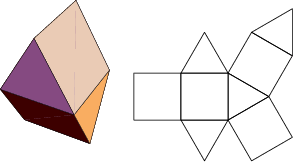Johnson solid

J27: the gyrobifastigium.
A Johnson solid is any convex polyhedron with regular faces that is not a Platonic solid, an Archimedean solid, or a prism (or an antiprism). There are 92 Johnson solids, which are named after Norman W. Johnson who was the first to catalog them in 1966. They included equilateral deltahedra and dipyramids (two pyramids placed symmetrically base to base) and any irregular convex solid that can be made by sticking together triangles, squares, pentagons, and so on, in a way that happens to close. Some of the simpler Johnson solids are assemblages of pyramids, prisms, and antiprisms; for example, a gyrobifastigium is two triangular prisms glued together with a twist. Others are fragments of Archimedean solids; for example, a pentagonal rotunda is half an icosidodecahedron. When stretched out with a prism this makes the marvelously named elongated pentagonal orthocupolarotunda.


